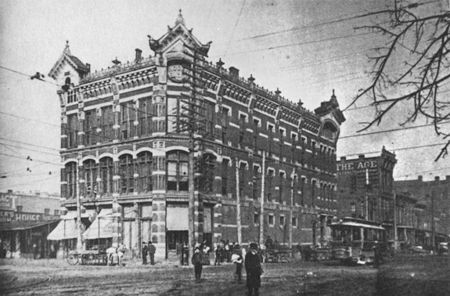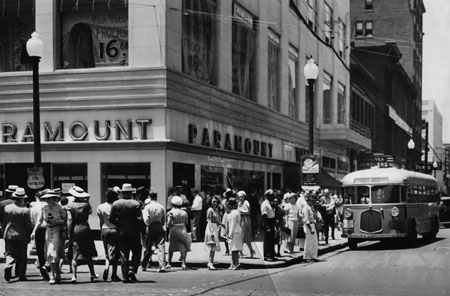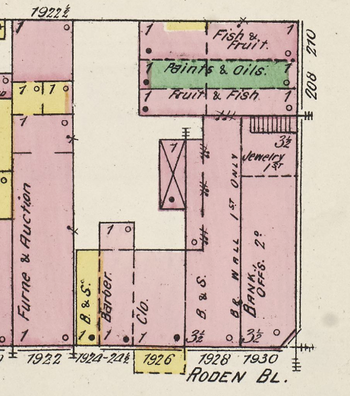Roden Block: Difference between revisions
No edit summary |
No edit summary |
||
| Line 1: | Line 1: | ||
[[Image:Roden Block 1890s.jpg|right|thumb|450px|The Roden Block in the 1890s]] | [[Image:Roden Block 1890s.jpg|right|thumb|450px|The Roden Block in the 1890s]] | ||
[[Image:Paramount Candies.jpg|right|thumb|450px|Paramount Candies and Parisian in the Roden Block in a 1941 ''Birmingham News'' photo]] | [[Image:Paramount Candies.jpg|right|thumb|450px|Paramount Candies and Parisian in the Roden Block in a 1941 ''Birmingham News'' photo]] | ||
The '''Roden Block''' or '''Roden's Block''', also called the '''Roden Building''' or, now, the '''Ingram Building''' is a commercial structure developed by [[Benjamin Roden]] before [[ | The '''Roden Block''' or '''Roden's Block''', also called the '''Roden Building''' or, now, the '''Ingram Building''' is a commercial structure developed by [[Benjamin Roden]] before [[1885]] on the southeast corner of [[Block 86]], northwest of the intersection of [[2nd Avenue North]] and [[20th Street North|20th Street]]. | ||
The richly-ornamented three-story commercial block with its heavy cornice and corner pediments was designed by architect [[Charles Wheelock]]. The building was constructed of pressed-brick with stone trim. The 2nd Avenue facade was the building's apparent "front", with blank walls facing 20th Street. Roden's grocery occupied the lower floor with a corner entrance. Offices were located on the second floor and sleeping rooms on the top. | The richly-ornamented three-story commercial block with its heavy cornice and corner pediments was designed by architect [[Charles Wheelock]]. The building was constructed of pressed-brick with stone trim. The 2nd Avenue facade was the building's apparent "front", with blank walls facing 20th Street. Roden's grocery occupied the lower floor with a corner entrance. Offices were located on the second floor and sleeping rooms on the top. | ||
| Line 29: | Line 29: | ||
** 1-2: [[Hickman & Hamill]] attorneys (1905) | ** 1-2: [[Hickman & Hamill]] attorneys (1905) | ||
** 2-6: [[Smith's College of Beauty Culture]] (1926) | ** 2-6: [[Smith's College of Beauty Culture]] (1926) | ||
*** 2: [[Thomson & Berry]], real estate & insurance brokers ( | *** 2: [[Thomson & Berry]], real estate & insurance brokers (1885–), [[Avondale Stove & Foundry Co.]] (1887), [[E. N. Hammill]] / [[M. H. VanDiver]] attorneys (1899) | ||
*** 6: [[S. L. Weaver]] attorney / [[C. R. Leonard]] collector (1899), [[N. E. Russell]] (1905) | *** 6: [[S. L. Weaver]] attorney / [[C. R. Leonard]] collector (1899), [[N. E. Russell]] (1905) | ||
** 3: [[Ivey Lewis]] attorney (1899-1905), [[W. F. Dickinson]] (1905) | ** 3: [[Ivey Lewis]] attorney (1899-1905), [[W. F. Dickinson]] (1905) | ||
** 5: [[R. A. McAdory]] (1899), [[J. A. Mitchell]] attorney ( | ** 5: [[R. A. McAdory]] (1899), [[J. A. Mitchell]] attorney (1899–1905) / [[F. Deedmeyer]] (1905), [[W. O. Snyder]] (1926) | ||
** 7: [[G. P. Moore]] / [[C. W. Hickman]] attorneys (1899), [[Avondale Land Co.]] (1905), [[R. Bethea & Co.]]/[[Birmingham Musicians Protective Association]] (1926) | ** 7: [[G. P. Moore]] / [[C. W. Hickman]] attorneys (1899), [[Avondale Land Co.]] (1905), [[R. Bethea & Co.]] / [[Birmingham Musicians Protective Association]] (1926) | ||
** 9: [[Central Coal Co.]] (1905) | ** 9: [[Central Coal Co.]] (1905) | ||
** 10: [[Robert Pearson|Robert H. Pearson]] attorney (1887-1905), [[Southland Studio]] (1926) | ** 10: [[Robert Pearson|Robert H. Pearson]] attorney (1887-1905), [[Southland Studio]] (1926) | ||
** 11: [[James Going]] real estate & insurance (1880s-1905), [[Malcolm Betha]] (1926) | ** 11: [[James Going]] real estate & insurance (1880s-1905), [[Malcolm Betha]] (1926) | ||
** 3rd floor: Moose Hall/[[John Nappi]] (1926) | ** 3rd floor: Moose Hall/[[John Nappi]] (1926) | ||
** [[M. W. Steele]], architect ( | ** [[M. W. Steele]], architect (1885–) | ||
** offices of the [[Avondale Stove & Foundry Co.]] (1887–) | ** offices of the [[Avondale Stove & Foundry Co.]] (1887–) | ||
** [[Ingram Law Offices]] | ** [[Ingram Law Offices]] | ||
** [[Lane, Taliaferro & Tabor]] attorneys ( | ** [[Lane, Taliaferro & Tabor]] attorneys (1885–1887) | ||
** [[Gregg & Weakley]] attorneys (1887) | ** [[Gregg & Weakley]] attorneys (1887) | ||
** [[Heflin & Knox]] attorneys (1887) | ** [[Heflin & Knox]] attorneys (1887) | ||
| Line 47: | Line 47: | ||
** [[Martin & McEachin]] attorneys, claim agent for A.G.S.R.R (1887) | ** [[Martin & McEachin]] attorneys, claim agent for A.G.S.R.R (1887) | ||
** [[C. E. Rice]] real estate (1887) | ** [[C. E. Rice]] real estate (1887) | ||
** [[YMCA of Greater Birmingham|YMCA]] ( | ** [[YMCA of Greater Birmingham|YMCA]] (1885–1926) | ||
** [[West End Land & Improvement Co.]] ( | ** [[West End Land & Improvement Co.]] (1887–1897) | ||
==References== | ==References== | ||
Revision as of 12:44, 24 May 2020
The Roden Block or Roden's Block, also called the Roden Building or, now, the Ingram Building is a commercial structure developed by Benjamin Roden before 1885 on the southeast corner of Block 86, northwest of the intersection of 2nd Avenue North and 20th Street.
The richly-ornamented three-story commercial block with its heavy cornice and corner pediments was designed by architect Charles Wheelock. The building was constructed of pressed-brick with stone trim. The 2nd Avenue facade was the building's apparent "front", with blank walls facing 20th Street. Roden's grocery occupied the lower floor with a corner entrance. Offices were located on the second floor and sleeping rooms on the top.
The Young Men's Christian Association rented a suite of rooms in the building on October 16, 1885. Birmingham National Bank replaced Roden's grocery April 1887. According to an 1887 business directory, the Birmingham Board of Aldermen held their meetings in the Roden Building.
By the autumn of 1917 the elaborate corner parapets had been removed.
In 1937 the Roden Block and adjacent Caheen Building at 1924 2nd Avenue North were combined and completely renovated by Miller, Martin & Lewis Architects for Parisian stores. The cornices were removed, window openings enlarged, and a new white stone cladding was installed with simplified geometric details. Parisian's storefront was completely updated again in a 1950 renovation that also included excavation of a storage basement and a mezzanine-level men's store. The new entrance, clad in glass and Alabama marble, featured the nation's first installation of touch-action hydraulically-operated doors, as well as backlit plexi-glass and neon signage.
A 2011 renovation for owners Kent and Angie Ingram was designed by architect Jeremy Erdreich.
Tenants
- Ground floor
- 20th Street North
- 200-204: Birmingham National Bank (1887-1891)
- 200: United Cigar Store (c. 1929), Paramount Candies (1930s), Corner Soda (1940s-50s), Paramount yogurt shop (2011–2013), Paramount bar (2013–)
- 202: shoe store/tobacco shop (c. 1929), Watts Apparel Shop (c. 1931)
- 204: J. M. Watson & Co. real estate (1899), Sophia Betsch barber (1905), Bon-Ton Hatters (1926-1929), Betty Maid Dresses, Zoe's Candies (1964), Subway Restaurant
- 206: jeweler (1891), Hanover Jewelry (c. 1929-1964)
- 200-204: Birmingham National Bank (1887-1891)
- 2nd Avenue North
- 1928: Wall & Giacopazzi wholesale produce (1880s), Benjamin Roden's grocery, Butler's Shoes
- 1930: Birmingham National Bank (1887-1891), Parisian (1937-1989)
- 20th Street North
- Rooms
- 1: John McQueen attorney (1899), Mercantile Collecting Co. (1905), Barham Edwards Loan Co. (1926)
- 1-2: Hickman & Hamill attorneys (1905)
- 2-6: Smith's College of Beauty Culture (1926)
- 2: Thomson & Berry, real estate & insurance brokers (1885–), Avondale Stove & Foundry Co. (1887), E. N. Hammill / M. H. VanDiver attorneys (1899)
- 6: S. L. Weaver attorney / C. R. Leonard collector (1899), N. E. Russell (1905)
- 3: Ivey Lewis attorney (1899-1905), W. F. Dickinson (1905)
- 5: R. A. McAdory (1899), J. A. Mitchell attorney (1899–1905) / F. Deedmeyer (1905), W. O. Snyder (1926)
- 7: G. P. Moore / C. W. Hickman attorneys (1899), Avondale Land Co. (1905), R. Bethea & Co. / Birmingham Musicians Protective Association (1926)
- 9: Central Coal Co. (1905)
- 10: Robert H. Pearson attorney (1887-1905), Southland Studio (1926)
- 11: James Going real estate & insurance (1880s-1905), Malcolm Betha (1926)
- 3rd floor: Moose Hall/John Nappi (1926)
- M. W. Steele, architect (1885–)
- offices of the Avondale Stove & Foundry Co. (1887–)
- Ingram Law Offices
- Lane, Taliaferro & Tabor attorneys (1885–1887)
- Gregg & Weakley attorneys (1887)
- Heflin & Knox attorneys (1887)
- A. O. Lane attorney (1887)
- Martin & McEachin attorneys, claim agent for A.G.S.R.R (1887)
- C. E. Rice real estate (1887)
- YMCA (1885–1926)
- West End Land & Improvement Co. (1887–1897)
References
- Pocket Business Directory and Guide to Birmingham, Ala. (1887) - accessed January 16, 2007
- City Directory of Birmingham, Alabama (1899) Atlanta, Georgia: Maloney Directory Co.
- Polk's Birmingham City Directory (1926) Birmingham: R. L. Polk & Co.
- White, Marjorie Longenecker (1977) Downtown Birmingham: Architectural and Historical Walking Tour Guide. Birmingham: Birmingham Historical Society.
- Fazio, Michael W. (2010) Landscape of Transformations: Architecture and Birmingham, Alabama. Knoxville, Tennessee: University of Tennessee Press ISBN 9781572336872
- Tomberlin, Michael (January 15, 2011) "Sweet dream project in downtown Birmingham remembers Paramount, Parisian's heyday." The Birmingham News


